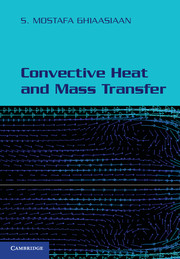Book contents
- Frontmatter
- Contents
- Preface
- Frequently Used Notation
- 1 Thermophysical and Transport Fundamentals
- 2 Boundary Layers
- 3 External Laminar Flow: Similarity Solutions for Forced Laminar Boundary Layers
- 4 Internal Laminar Flow
- 5 Integral Methods
- 6 Fundamentals of Turbulence and External Turbulent Flow
- 7 Internal Turbulent Flow
- 8 Effect of Transpiration on Friction, Heat, and Mass Transfer
- 9 Analogy Among Momentum, Heat, and Mass Transfer
- 10 Natural Convection
- 11 Mixed Convection
- 12 Turbulence Models
- 13 Flow and Heat Transfer in Miniature Flow Passages
- APPENDIX A Constitutive Relations in Polar Cylindrical and Spherical Coordinates
- APPENDIX B Mass Continuity and Newtonian Incompressible Fluid Equations of Motion in Polar Cylindrical and Spherical Coordinates
- APPENDIX C Energy Conservation Equations in Polar Cylindrical and Spherical Coordinates for Incompressible Fluids With Constant Thermal Conductivity
- APPENDIX D Mass-Species Conservation Equations in Polar Cylindrical and Spherical Coordinates for Incompressible Fluids
- APPENDIX E Thermodynamic Properties of Saturated Water and Steam
- APPENDIX F Transport Properties of Saturated Water and Steam
- APPENDIX G Properties of Selected Ideal Gases at 1 Atmosphere
- APPENDIX H Binary Diffusion Coefficients of Selected Gases in Air at 1 Atmosphere
- APPENDIX I Henry's Constant, in bars, of Dilute Aqueous Solutions of Selected Substances at Moderate Pressures
- APPENDIX J Diffusion Coefficients of Selected Substances in Water at Infinite Dilution at 25°C
- APPENDIX K Lennard–Jones Potential Model Constants for Selected Molecules
- APPENDIX L Collision Integrals for the Lennard–Jones Potential Model
- APPENDIX M Some RANS-Type Turbulence Models
- APPENDIX N Physical Constants
- APPENDIX O Unit Conversions
- APPENDIX P Summary of Important Dimensionless Numbers
- APPENDIX Q Summary of Some Useful Heat Transfer and Friction-Factor Correlations
- References
- Index
7 - Internal Turbulent Flow
- Frontmatter
- Contents
- Preface
- Frequently Used Notation
- 1 Thermophysical and Transport Fundamentals
- 2 Boundary Layers
- 3 External Laminar Flow: Similarity Solutions for Forced Laminar Boundary Layers
- 4 Internal Laminar Flow
- 5 Integral Methods
- 6 Fundamentals of Turbulence and External Turbulent Flow
- 7 Internal Turbulent Flow
- 8 Effect of Transpiration on Friction, Heat, and Mass Transfer
- 9 Analogy Among Momentum, Heat, and Mass Transfer
- 10 Natural Convection
- 11 Mixed Convection
- 12 Turbulence Models
- 13 Flow and Heat Transfer in Miniature Flow Passages
- APPENDIX A Constitutive Relations in Polar Cylindrical and Spherical Coordinates
- APPENDIX B Mass Continuity and Newtonian Incompressible Fluid Equations of Motion in Polar Cylindrical and Spherical Coordinates
- APPENDIX C Energy Conservation Equations in Polar Cylindrical and Spherical Coordinates for Incompressible Fluids With Constant Thermal Conductivity
- APPENDIX D Mass-Species Conservation Equations in Polar Cylindrical and Spherical Coordinates for Incompressible Fluids
- APPENDIX E Thermodynamic Properties of Saturated Water and Steam
- APPENDIX F Transport Properties of Saturated Water and Steam
- APPENDIX G Properties of Selected Ideal Gases at 1 Atmosphere
- APPENDIX H Binary Diffusion Coefficients of Selected Gases in Air at 1 Atmosphere
- APPENDIX I Henry's Constant, in bars, of Dilute Aqueous Solutions of Selected Substances at Moderate Pressures
- APPENDIX J Diffusion Coefficients of Selected Substances in Water at Infinite Dilution at 25°C
- APPENDIX K Lennard–Jones Potential Model Constants for Selected Molecules
- APPENDIX L Collision Integrals for the Lennard–Jones Potential Model
- APPENDIX M Some RANS-Type Turbulence Models
- APPENDIX N Physical Constants
- APPENDIX O Unit Conversions
- APPENDIX P Summary of Important Dimensionless Numbers
- APPENDIX Q Summary of Some Useful Heat Transfer and Friction-Factor Correlations
- References
- Index
Summary
General Remarks
Near-wall phenomena in internal turbulent flow has much in common with external turbulent flow, and the discussions of property fluctuations and near-wall phenomena in the previous chapter all apply to internal flow as well. The confined nature of the flow field, however, implies that, unlike external flow in which the free-stream conditions are not affected by what happens at the wall, the transport phenomena at the wall do affect the mean flow properties.
Consider fully developed internal flow in a smooth pipe, shown in Fig. 7.1. Similar to external flow, the entire flow field in the pipe can be divided into three zones: the viscous sublayer, the buffer zone, and the turbulent core. The mean thickness of the viscous sublayer is equal to y+ = 5, where y+ = yUτ/v is the distance from the wall in wall units and the buffer zone extends to y+ = 30. Close to the wall, where the effect of wall curvature is small and the fluid is not aware that the overall flow field is actually confined, the universal velocity profile presented in Eqs. (6.5.1)–(6.5.3) apply. Only when we approach the centerline does Eq. (6.5.3) deviate from measurements. Similar observations can be made about noncircular ducts.
- Type
- Chapter
- Information
- Convective Heat and Mass Transfer , pp. 208 - 242Publisher: Cambridge University PressPrint publication year: 2011



